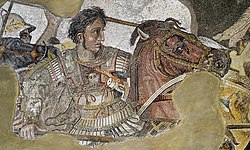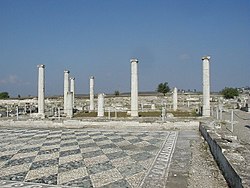See all articles relating to: North Macedonia

North Macedonia region was once home to ancient Paeonian and Dardanian tribes before becoming part of the Roman Empire in the 2nd century BCE. Notably, it was the birthplace of Alexander the Great, one of the most famous military commanders in history, who created a vast empire in the 4th century BCE. The nation's history was further shaped by the arrival of the Slavs in the 6th century, and the establishment of the medieval kingdom of Macedon under Tsar Samuel in the 10th century. North Macedonia has been influenced by various cultures and empires throughout its history, including the Byzantine Empire, the Ottoman Empire, and the Kingdom of Yugoslavia, before finally gaining independence in 1991. Today, it stands as a unique testament to its multifaceted past, which can be witnessed through its historic landmarks, religious monuments, and archaeological sites.
Research your ancestors on MyHeritage
North Macedonian history
See also:
In ancient times the region approximating to North Macedonia today was inhabited by the Paeonians, an Indo-European people. However, the Kingdom of Macedon, which existed in one form or another from the seventh century BCE onwards, covered a much larger geographical region, eventually covering what is now northern Greece. It was from here that Philip II began conquering much of central Greece and the Peloponnese in the 350s and 340s BCE after he reformed the Macedonian army and adopted the phalanx as its military methodology.[1]

Philip was a brilliant ruler, but he is often overlooked owing to the incredible conquests which his son, Alexander the Great, undertook following his accession in 336 BCE. In a reign of just thirteen years he conquered much of the southern Balkans, consolidated Macedonian control over Greece and then set out to conquer the vast Persian Empire which covered Turkey, the Levant, Egypt, Mesopotamia and Persia at that time. He achieved this by 330 BCE and then kept going, conquering Bactria around modern-day Afghanistan and then campaigning as far east as the Indus Valley in India, the limits of the known world at the time. But he died prematurely in 323 BCE and his empire fragmented into several successor states. Nevertheless, his conquests transformed the Eastern Mediterranean and the Near East and ushered in the Hellenistic Age as Greek culture spread far and wide.[2]
Macedonia itself was conquered in the process of several wars waged against it by the Roman Republic between the late third century BCE and the mid-second century BCE. At the end of the Fourth Macedonian War in 148 BCE Macedonia was transformed into a Roman province. It would remain under Roman and then Byzantine rule for centuries to come.[3] The ethnic composition of the country was changed considerably in the early medieval period as South Slavic peoples settled in Macedonia, drawing Macedonia closer to the rest of the Balkans culturally and away from its Greek past. Meanwhile, dominance of the region switched hands over time, with the Bulgars becoming dominant here between the eighth and early eleventh centuries, before the Byzantines resumed control over the area, followed by a Bulgar resumption and finally a Serb ascendancy, as Tsar Stefan Dušan made Skopje the capital of the Serbian Empire in the fourteenth century.[4]
Although North Macedonia briefly enjoyed independence in the shape of the Kingdom of Prilep following the collapse of the Serbian Empire, it soon fell under the control of the Ottoman Turks in 1395. Macedonia remained under Turkish rule for the next half a millennium, administered as part of the wider administrative region of Rumelia. Owing to its proximity to the center of Ottoman rule in Istanbul, Macedonia was one of the last parts of the Balkans to leave the Ottoman Empire, with historic Macedonia being broadly dismembered by its emergent neighbors, Serbia, Greece and Bulgaria following the Balkan Wars of the early 1910s.[5]
From this juncture, North Macedonia was largely controlled by Serbia, first through the Kingdom of Serbia, then the Kingdom of Serbs, Croats and Slovenes from 1918 onwards and as part of Yugoslavia from 1929. This would remain the case until 1991 when Macedonia seceded from Yugoslavia on the 8th of September that year. The Serbs, who were already becoming embroiled in other wars to stop the Yugoslav state disintegrating, did little to prevent Macedonia seceding. In 2019 the country changed its name to North Macedonia to appease Greek demands that it do so as a means of beginning accession talks to the European Union. However, North Macedonia also faces opposition to its membership from Bulgaria and its development in modern times has been stymied by its neighbors.[6]
North Macedonian geography

North Macedonia is a landlocked country which is quite mountainous and has several large lakes such as Lake Ohrid, which, with a mean depth of 155 meters, is the deepest lake in the Balkans. The region occupied by North Macedonia today only covers a certain proportion of historic Macedonia. For instance, the ancient capital of Alexander the Great’s empire, the city of Pella, is not part of North Macedonia today. Instead it, and the rest of historic Macedonia, are located in northern Greece, a fact which led Greece to push for Macedonia to change its name to North Macedonia in 2019 as a pre-requisite of normalizing relations between the two countries.[7] Skopje is the only major city in the country. With a metropolitan population of just over 600,000 people (420,000 in the urban area), it is peopled by 30% of the inhabitants of Macedonia, which number around two million. Beyond Skopje the next largest urban centers are a number of towns such as Bitola, Kumanovo and Prilep with between 60,000 and 75,000 inhabitants each.[8]
Researching family history in North Macedonia
While there are a good many Ottoman records available for the study of family history in Macedonia in the nineteenth century, these are not comprehensive demographic records and, moreover, are generally only available by consulting the original documents, which are in Turkish and written in difficult handwriting. The first modern census for the region, one which systematically records the demography of North Macedonia, was the national census undertaken throughout the Kingdom of the Serbs, Croats and Slovenes in 1921, followed by the Yugoslav census of 1931.[9] Many demographic records are available to consult at the State Archives of the Republic of North Macedonia, which were established in 1951.[10]
See also:
North Macedonia ethnicity

North Macedonia's population is composed of ethnic Macedonians. The country also has a significant Albanian minority that predominantly inhabits the northwestern part of the country. Other ethnicities present in North Macedonia include Turks, Serbs, Bosniaks, and Vlachs, each contributing to the nation's vibrant cultural tapestry.
See also:
North Macedonian surnames
North Macedonian surnames often carry valuable information about ancestry, geographical origins, and familial ties, making them an important starting point in genealogical research. Many of these surnames are patronymic, derived from the given name of a male ancestor, and may end with the suffix "-ski" or "-ov". By examining North Macedonian surnames, researchers can gain crucial insights into their family's past, enabling them to establish connections to specific regions, historical periods, or occupations, thus facilitating a more comprehensive understanding of their ancestry.
See also:
References
- ↑ https://www.worldhistory.org/Philip_II_of_Macedon/
- ↑ https://www.history.com/topics/ancient-greece/alexander-the-great
- ↑ https://academic-accelerator.com/encyclopedia/macedonian-wars
- ↑ https://www.theatlantic.com/magazine/archive/1991/06/historys-cauldron/518073/
- ↑ https://www.britannica.com/place/North-Macedonia/The-Ottoman-Empire
- ↑ https://www.bbc.com/news/world-europe-17550407
- ↑ https://www.countryreports.org/country/macedonia/geography.htm
- ↑ http://www.citypopulation.de/en/northmacedonia/cities/
- ↑ https://www.stat.gov.mk/OblastOpsto_en.aspx?id=2
- ↑ https://arhiv.mk/en/istorijat/


